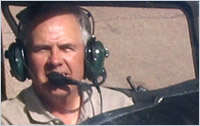by Greg Brown,
Is it worth learning to fly at an older age? Yes, even at 54, says this retired Air Force Lt Col.
Feeling too old to learn to fly? Let’s change that feeling.
Age is not a factor when determining if you can obtain your pilot’s license. Health and physical ability, yes…but not age. To help prove it, my friend and retired Air Force Lt. Col. Chevy Chevallard added his own encouragement in response to an email I received from Jeanne Peterson, who was struggling through her private pilot lessons at an older age. (See yesterday’s blog post.)
Dear Jeanne:
You are to be commended for this endeavor, and I’m betting you’re becoming an excellent, wise, and SAFE pilot! And yes, it can get discouraging. I had a heck of a time figuring out the “round out.” Finally, my instructor said, “Chevy,” what do you see when you look at the cowling? I said, “I’ve never really seen the cowling!” (I’m 5. 6″) I was sitting on a pillow, but apparently it was about one inch too thin. That day we added a second cushion, and my round out problem went away for good. But it sure was frustrating! I think it’s especially so when, like you, I’ve “been there, done that” in a lot of ways, and I just couldn’t GET IT. But I did, and you will too. SO glad you’ve taken up this challenge!
For context, here’s my story: About a month before I retired from the Air Force, I joined the flying club at my base, Peterson Air Force Base, Colorado. At the time I was 54 and change. I started ground school and flight training in August 2004. I finished ground school eight weeks later, and rather than follow the conventional wisdom “Take your FAA Knowledge Exam ASAP,” I decided to wait. I had done very well in my ground school written stage checks, but I just didn’t feel I KNEW the material. So, I took another six months to study and well, I was the only member of my ground school class to ACE the test. I kind of felt the same way about taking the practical test, too. So, I trained for 16 months, accumulating about 100 hours before I took that test, and, again, did well. Since then, I’ve found a flying partner (my former flight instructor, who’s 83, an active CFI at our club, who has over 5000 hours (many of it as a career Air Force pilot, the rest as as CFI), and who skis 20 weekends a year), and we take short cross countries. From these experiences, I’ve learned a little about instrument flying, including GPS, too. I fly once or twice a month, and that’s wonderful for me and my schedule. I continue to read voraciously (I still take AOPA Flight Training) and I photocopy articles that cover “weak spots” I need to focus on. Then the next time I have an opportunity to fly (solo or with my flying buddy), I’ll pick an issue or two to focus on, and apply it. Last week I focused on what to do if my seat slips back on the rails during takeoff (answer: pull back on the throttle, not the yoke!).
Chevy
Carl “Chevy” Chevallard, PhD, LtCol (USAF, Ret)
Colorado Springs, CO
So, tell me… What concerns do you have about learning to fly an airplane or getting your Pilot’s license? Again, answer in the comments section below.
About Greg
Greg Brown is an award winning flight instructor, pilot, author and columnist. In 2000, he was the National Flight Instructor of the Year. Greg writes the Flying Carpet column for AOPA’s Flight Training magazine and co-authored You Can Fly! with Laurel Lippert. His other books include Flying Carpet, The Savvy Flight Instructor, The Turbine Pilot’s Flight Manual, and Job Hunting for Pilots. Visit Greg Brown’s own blog at www.GregBrownFlyingCarpet.com.





